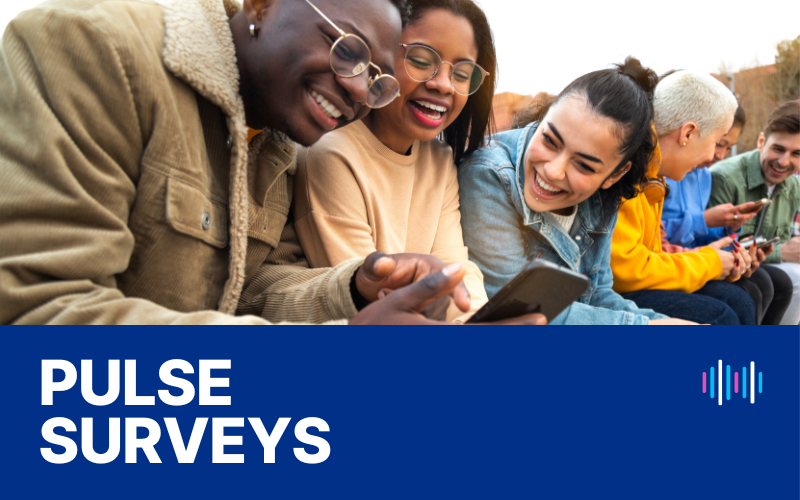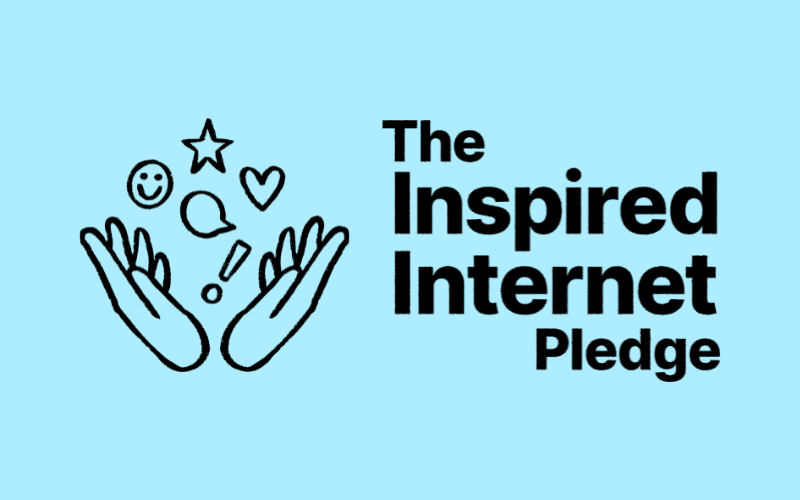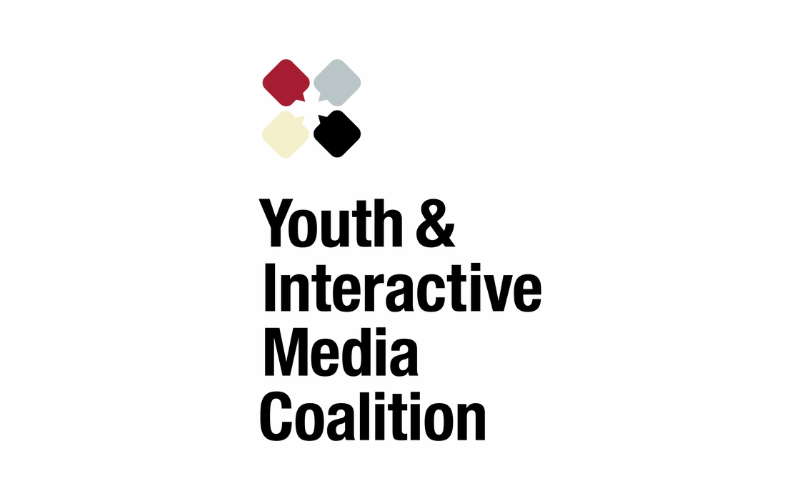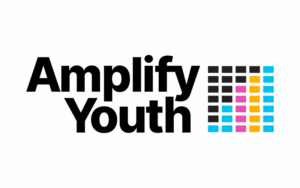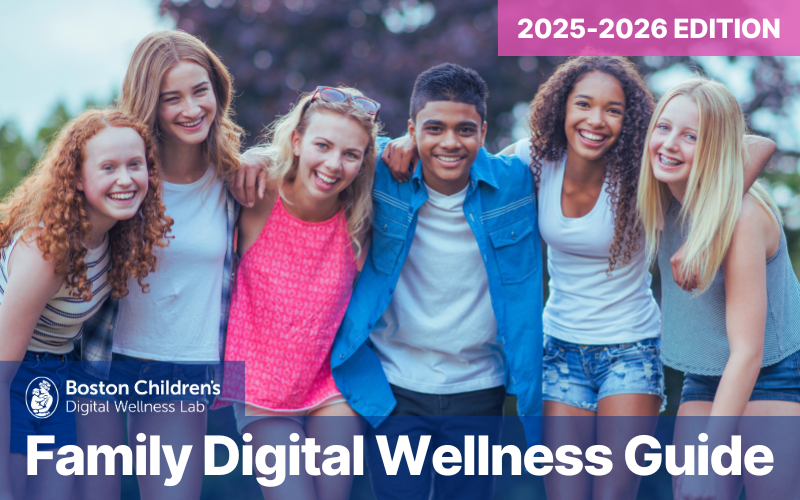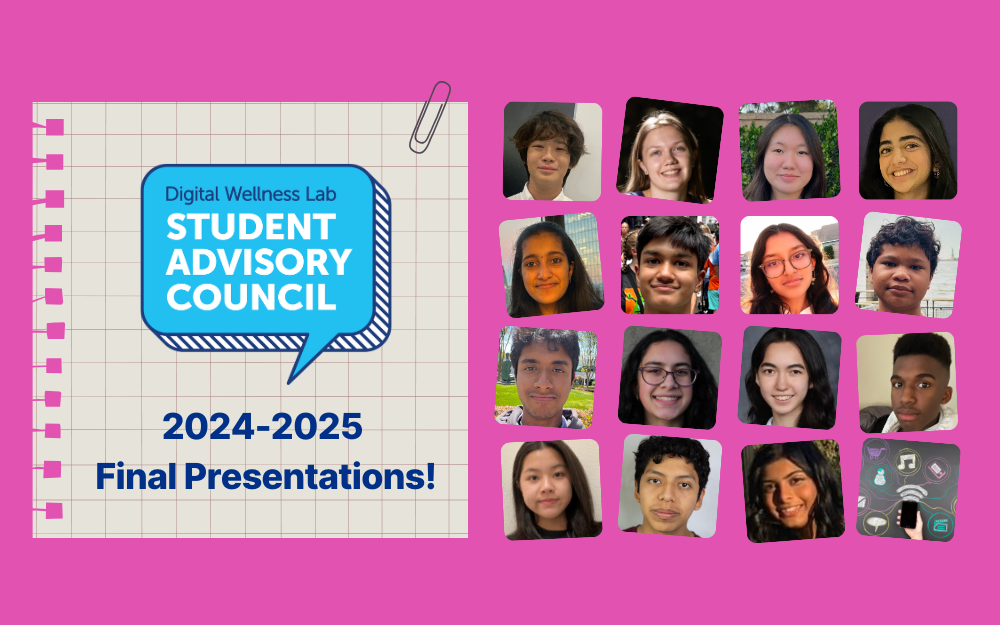The Digital Wellness Lab convened its 2024-2025 Student Advisory Council, a dynamic group of 17 high school students from around the United States, for their year-end presentations – a powerful testament to the importance of amplifying youth voices in technology research.
The meeting showcased the students’ deep dives into critical aspects of digital well-being through three engaging group discussions.
Group 1: Mindful Media Use
Presented by: Jeremy, Julia, Nina, Taanvi, Tara, Gabby, Blooma
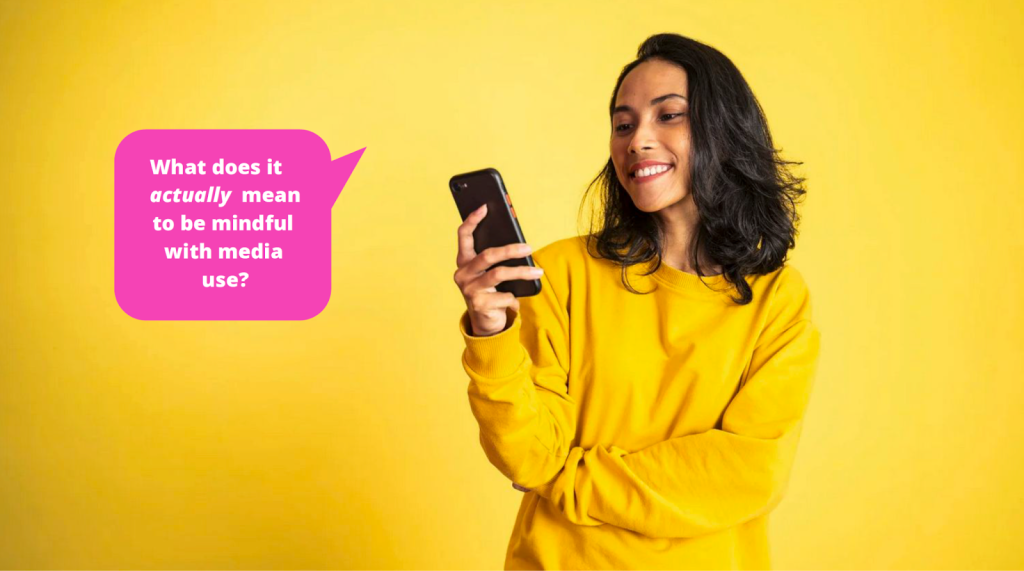
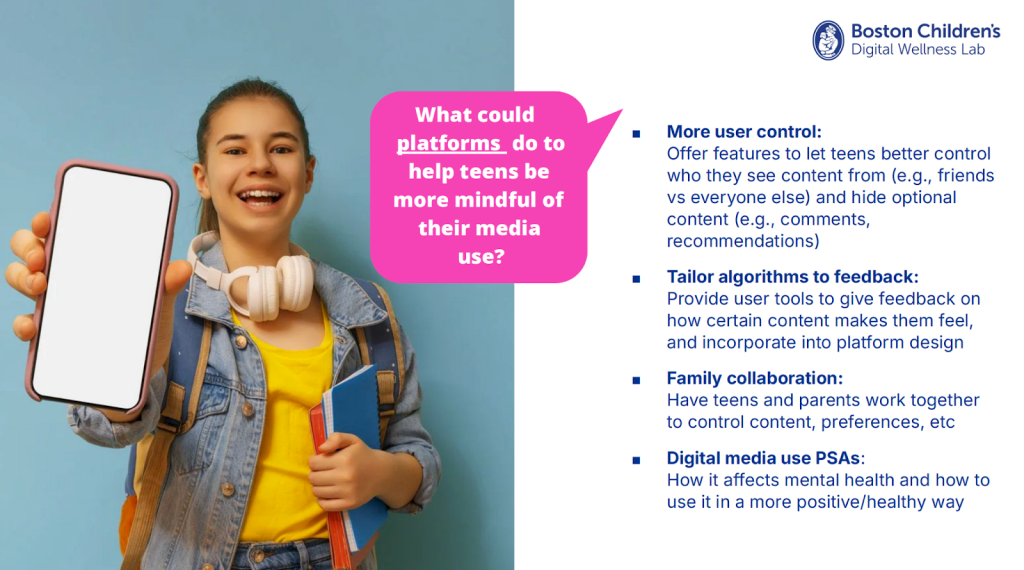
The first group delved into the crucial topic of mindful media use, offering profound insights into how teenagers navigate their digital lives and envision healthier habits. The discussion centered on the core principle of intentionality: encouraging teens to actively reflect on their technology consumption and its impact on their overall well-being.
The students articulated that mindful media use goes beyond simply tracking screen time; it involves a deeper awareness of purpose. They emphasized the importance of understanding why they reach for their devices and whether that aligns with their goals and values. Recognizing the difference between productive engagement – using technology for learning, connection, or creative pursuits – and unproductive consumption – often characterized by mindless scrolling – was another key takeaway.
The teens shared practical strategies they already employ to foster mindful use, including leveraging built-in screen time monitoring features to gain awareness of their habits. The concept of device-free zones, particularly bedrooms, was highlighted as a way to promote better sleep and reduce distractions. Parental controls, when implemented collaboratively, were also seen as a supportive tool for setting boundaries and fostering accountability.
The students further showcased innovative tools they’ve discovered to manage digital distractions. Focus Traveler, an app that gamifies studying, provides motivation to stay on task. The Opal app helps users block distracting applications and gain insights into their daily screen time. For YouTube users, the Unhook Chrome extension offers a way to eliminate distracting recommended videos, allowing for more focused content consumption.
Looking ahead, the students offered valuable recommendations for platforms. They advocated for more user control, suggesting customizable content filters and improved notification management. The idea of family controls, emphasizing collaboration and shared decision-making between parents and teens, was proposed as a more effective alternative to unilateral restrictions. Finally, the group stressed the need for impactful Public Service Announcements (PSAs) that educate users about the mental health implications of excessive screen time and promote positive media consumption habits. This session underscored the importance of empowering teens to take control of their digital experiences and cultivate a more balanced relationship with technology.
Group 2: Understanding Bias in AI
Presented by: Catriona, Oscar, Richa, Yuki, Geo
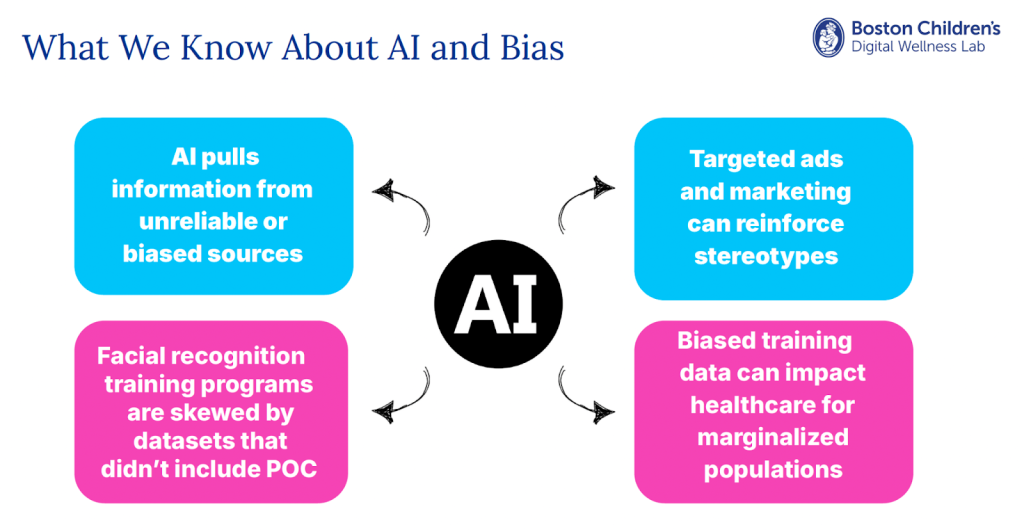
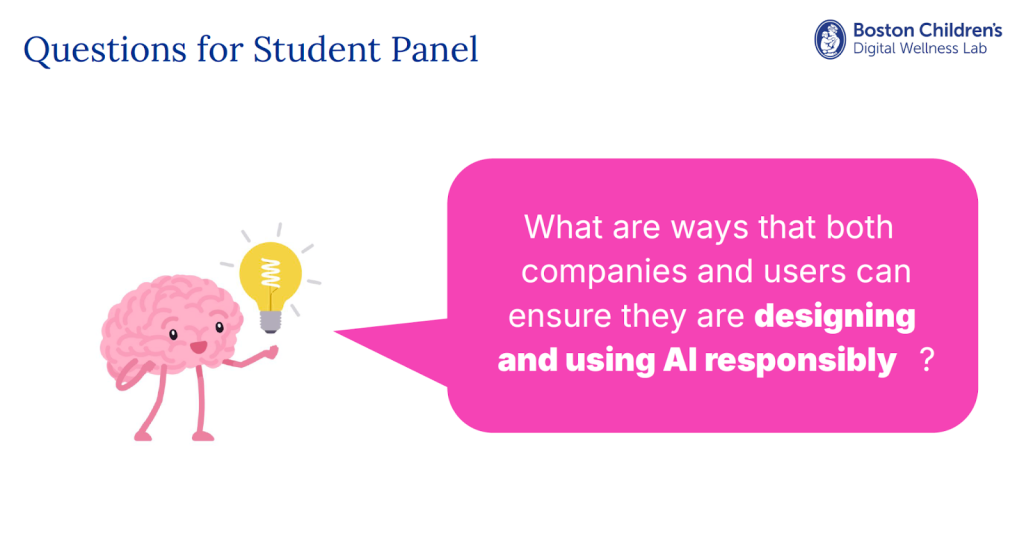
The second group of the Digital Wellness Lab’s Student Advisory Council tackled a critical and increasingly relevant topic: understanding bias in Artificial Intelligence (AI). Their discussion illuminated how these powerful systems can inadvertently reflect and even amplify existing societal biases, leading to real-world consequences.
The students presented stark examples of AI bias across various applications. They pointed out the well-documented failures of facial recognition technology to accurately identify individuals with darker skin tones, a flaw that can lead to systemic exclusion and injustice. In healthcare AI, concerns were raised about biased outcomes stemming from training data that predominantly features specific demographics, potentially dis-advantaging underrepresented groups in diagnosis and treatment. The pervasive influence of social media algorithms was also scrutinized, with students highlighting how these systems can reinforce harmful stereotypes by curating content that mirrors societal biases, negatively impacting users’ self-image and mental well-being.
A central theme of the discussion was the understanding that AI’s biases often originate from the biased or non-diverse datasets used to train these systems. The students clearly articulated how a lack of representation in training data can lead to AI tools that fail to accurately recognize or effectively serve marginalized communities, ultimately perpetuating harmful stereotypes and limiting opportunities.
To address this critical issue, the students offered insightful recommendations. They emphasized the urgent need for more diverse training data to ensure AI systems are representative and equitable. They also called for consumer education initiatives to empower users to understand the origins of AI-generated content and critically evaluate its reliability. Finally, they advocated for the development and implementation of bias mitigation algorithms that can actively identify and correct biased outputs, promoting fairness and inclusivity in AI applications.
Recognizing the rapidly evolving landscape of AI, the students passionately discussed the necessity of integrating AI literacy into education. They argued that equipping students with the skills to critically evaluate AI-generated content and understand its implications is no longer optional but essential. Educational programs should focus on the ethical use of AI and its potential biases, fostering responsible digital citizenship from a young age. The students also highlighted the potential for valuable collaboration between tech companies and educational institutions in developing resources and providing real-world insights into AI applications, ensuring that the next generation is equipped to navigate an AI-driven world with awareness and critical thinking.
Group 3: Analyzing Platform Settings & Tools from a Perspective of Wellbeing
Presented by: Eva, Julia, Kelsey, Mason, Noah, Leena, Laila
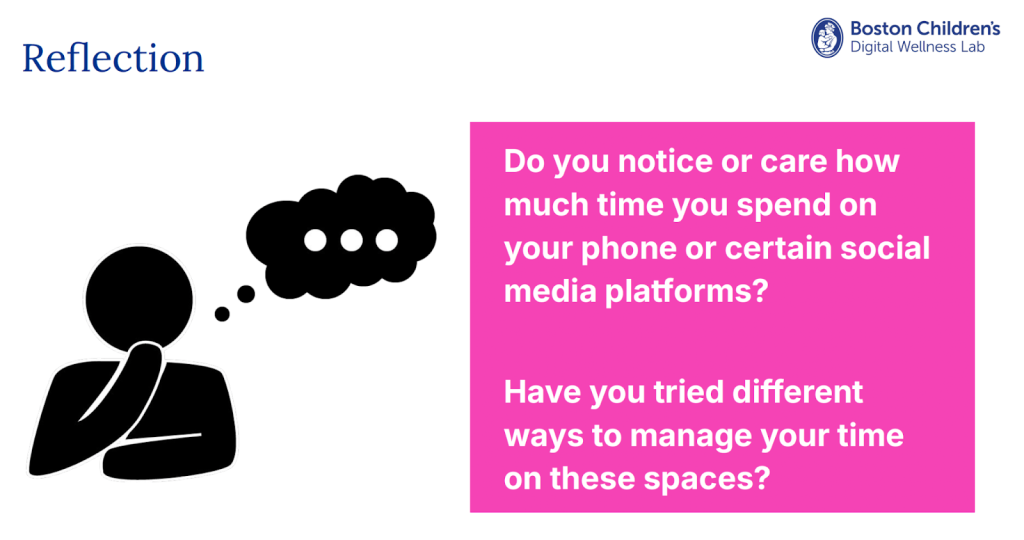
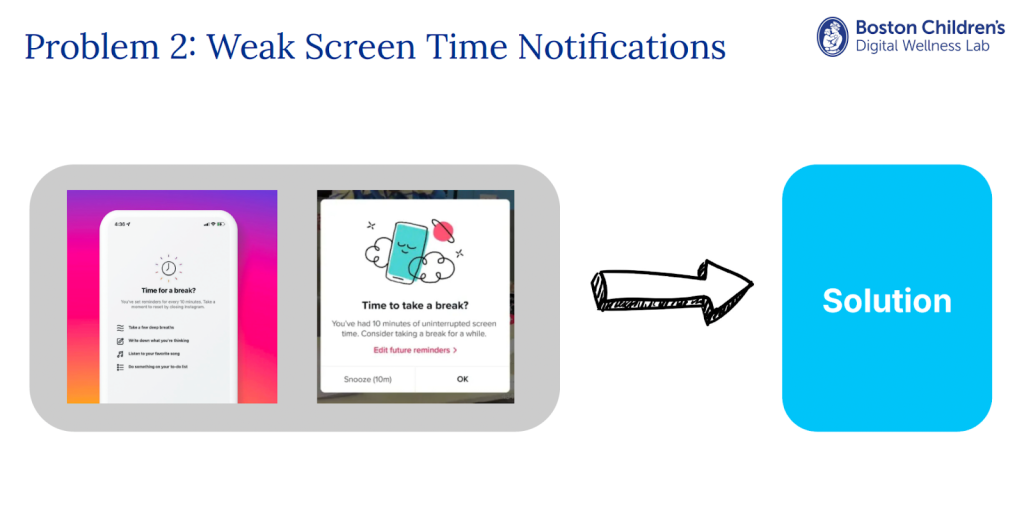
The third group centered on how platform settings and tools significantly impact user well-being, particularly for teenagers. The students began by highlighting the concerning statistics from the CDC, reporting that approximately 50% of US teens spend over four hours daily on screens, a trend correlated with increased rates of anxiety and depression.
They further elaborated on the cascading negative effects of excessive screen time, including disrupted sleep patterns, which can worsen existing mental health challenges. The link between high screen usage and reduced physical activity, leading to sedentary lifestyles with detrimental effects on overall health, was also a key point. Moreover, the students astutely recognized how social media platforms can foster environments ripe for unrealistic comparisons and pressures, ultimately contributing to feelings of inadequacy and anxiety among their peers.
A critical observation made by the students was the often-ineffective implementation of existing well-being features. While many platforms offer tools like screen time monitoring, the students pointed out that these features are frequently difficult to locate within app settings or designed with notifications that are easily dismissed or ignored. This lack of visibility and engaging design hinders their utility in promoting healthier digital habits. The students passionately argued for the need for more prominent and engaging reminders or prompts that actively encourage users to pause and reflect on their screen time.
To address these shortcomings, the group proposed several proactive strategies for platforms. They suggested the creation of engaging educational videos that clearly highlight the benefits of utilizing well-being features, making them more appealing and accessible to users. Strategic in-app advertising could also serve as timely reminders about available tools that support healthier media consumption. Furthermore, the students suggested collaboration with influencers and popular content creators to amplify the reach and effectiveness of these promotional efforts, ensuring the message resonates authentically with their target audience.
The students’ recommendations for tangible platform improvements included more visible screen time notifications that actively prompt users to take breaks and reflect on their usage. They also suggested incorporating setup questions about screen time preferences during account creation as a way to encourage mindful usage from the outset. Finally, they emphasized the crucial need for better accessibility of well-being tools within apps, ensuring that these features are easily discoverable and navigable, empowering teens to take control of their digital habits and prioritize their overall well-being.
Final Thoughts
Lab Director and Founder, Dr. Michael Rich, expressed profound gratitude for the students’ contributions and underscored their pivotal role in shaping the future of technology. He emphasized that as primary users of digital tools, young people possess unique perspectives that are invaluable in driving meaningful and positive change. Dr. Rich passionately encouraged ongoing dialogue between students and technology companies, envisioning a collaborative approach to foster responsible and beneficial technology development.
A particularly thought-provoking proposal from Dr. Rich was the consideration of a ‘capability-based licensing system’ for social media use, drawing a parallel to graduated driver’s licenses. This innovative system could assess a user’s understanding of digital literacy and responsible online behavior before granting full access to social media platforms. He envisioned tiered access levels, allowing younger users to engage with limited features initially, with more capabilities unlocking as they demonstrate responsible usage. Crucially, this system could incorporate educational components, such as training modules on digital citizenship and the impact of social media, empowering users to make informed decisions about their online presence.
The students then transitioned the discussion to digital literacy education, exploring the potential roles of schools and technology companies in its delivery. While acknowledging the platforms’ intrinsic understanding of their own systems and potential risks, the students leaned towards a collaborative approach between educational institutions and tech companies. This partnership, they argued, could create more effective and relevant digital literacy programs.
A key concern raised by the students was the accessibility of existing well-being resources. They noted that while many platforms offer valuable settings designed to promote digital wellness, such as screen time limits and content filters, these features are often hidden within menus or not clearly communicated during the initial setup, leading to widespread unawareness among their peers. The students strongly advocated for increased visibility and comprehensive education about these tools to empower teens to manage their screen time effectively and prioritize their overall well-being.
Looking to the future, the students made a compelling case for making digital literacy a mandatory course in schools. They firmly believe that such a curriculum would equip them with the essential skills needed to navigate the increasingly digital world responsibly. This mandatory education could cover critical areas such as identifying credible online sources, understanding and managing privacy settings, and recognizing the profound impact of social media on mental health. Implementing digital literacy education early in their academic journeys, the students argued, would foster healthier online habits and critical thinking skills, setting them up for success and well-being in an increasingly digital society.
We are so proud of our 2024-2025 Student Advisory Council and their final presentations underscored the critical need to listen to and learn from young people as we collectively strive to create a healthier and more positive digital landscape.

